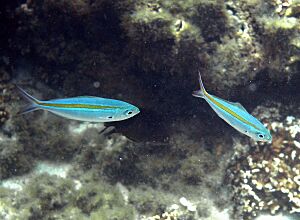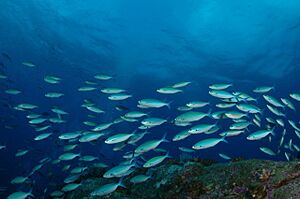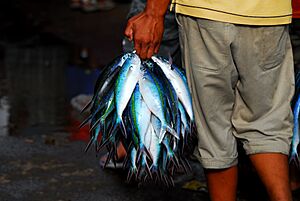Blue and gold fusilier facts for kids
Quick facts for kids Blue and gold fusilier |
|
|---|---|
 |
|
| Conservation status | |
| Scientific classification | |
| Synonyms | |
|
The blue and gold fusilier (Caesio caerulaurea) is a type of ocean fish. It is also known as the blue fusilier, gold-band fusilier, or scissor-tailed fusilier. This fish lives in the warm, tropical waters of the Indo-Pacific region, including the Red Sea.
Contents
About the Blue and Gold Fusilier
The blue and gold fusilier was first officially named in 1801. A French scientist named Bernard Germain de Lacépède described it. He found the first examples of this fish in Molucca, Indonesia.
The fish's scientific name, caerulaurea, comes from Latin words. Caeruleaus means "sky blue," and aureus means "golden." This name describes the fish's blue back and the yellow stripe on its side.
What Does It Look Like?
The blue and gold fusilier has a long, torpedo-shaped body. It is a bit flattened on the sides. It has small, cone-shaped teeth in its mouth.
The fish has two main fins on its back (called the dorsal fin). It also has one fin underneath (called the anal fin). These fins have both stiff spines and soft rays. They even have scales!
This fish can grow up to 35 centimeters (about 14 inches) long. However, most are around 25 centimeters (10 inches). Its body is bluish on top and turns white underneath. A bright yellow or golden stripe runs along its side. This stripe has thin white or pale blue lines on both edges. The stripe continues as dark streaks on the two parts of its tail fin. This makes its tail look like scissors.
Where Do They Live?
The blue and gold fusilier lives in many tropical parts of the Indo-Pacific. You can find it along the eastern coast of Africa, from the Red Sea down to South Africa. It also lives across the Indian Ocean and into the Pacific Ocean.
In the Pacific, its range goes as far east as French Polynesia. It can be found north of southern Japan and south of Vanuatu and New Caledonia. In Australia, it lives from Shark Bay in Western Australia up to Cassini Island. It is also found in the Timor Sea and along the northern Great Barrier Reef. Sometimes, it can be seen as far south as Sydney. It also lives near Christmas Island and Lord Howe Island.
These fish usually live in water between 2 and 40 meters (6.5 to 130 feet) deep. They prefer coastal areas, lagoons, and reefs that face the open sea. They especially like places where corals are growing well.
How They Live
Blue and gold fusiliers swim in large groups called schools. They swim in the middle of the water, eating tiny animals called zooplankton. These fish become ready to have babies quite early in life. They lay many small eggs that float in the water. They can lay eggs throughout most of the year, often during certain moon cycles.
Reproduction and Spawning
Blue and gold fusiliers have a special way of finding a mate and laying eggs. This process involves six different steps.
As evening approaches, one or two male fish will swim near a female. They gently nudge her belly, which is usually swollen with eggs. This happens about 60 to 90 minutes before they lay eggs. After a while, the fish stop this behavior and return to their main school.
Less than an hour before laying eggs, two to six males will compete. They try to get their bodies as close to the female's as possible. Once one male has pushed the others away, the male and female swim upwards in a spiral. They go towards the surface of the water. There, they release their eggs and sperm. Other "sneaker" males might then quickly release their own sperm in the same spot. Sometimes, a pair can manage to lay their eggs without other males joining in.
Fishing for Fusiliers
The blue and gold fusilier is an important fish for people who fish near the coast. You can often see them for sale in fish markets in places like Indonesia and the Philippines.
Fishermen catch them using different methods. These include special nets that drive fish in, gill nets, fish traps, and handlines. Sometimes, young fusiliers are used as bait to catch tuna. This fish is usually caught along with other types of fusiliers. Sadly, there is also illegal fishing of this species. This happens when people use explosives in the sea to catch fish.




